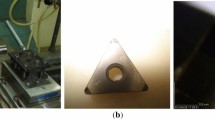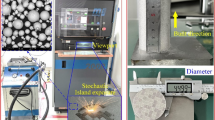Abstract
This paper aims at revealing how tool paths influence the fatigue resistance of high-speed ball-end hard milled surfaces and proposing corresponding tool path selection methods. Three kinds of tool paths (tool paths A, B, and C with angles relative to the length direction of cuboid workpiece 0°, 90°, and 45°, respectively) were utilized during high-speed milling process of hardened AISI D2 steel. The fatigue resistance of samples for different tool paths was evaluated through three-point bending fatigue tests. Results shows that tool paths have significant effect on fatigue resistance, and the maximum discrepancy in fatigue life can reach about 37.6% for different tool paths. Samples for tool path C shows the longest fatigue life when radial depth of cut ae = 0.1 mm. However, with the further increase of ae, samples for tool path A have the best fatigue resistance, followed by tool path C and B. Microscopic stress concentration and effective residual stress are the main ways by which tool paths influence the fatigue resistance. Changing tool paths leads to the difference in surface topography orientation and then in degree of microscopic stress concentration. Moreover, the effective residual stress (residual stress component in direction parallel to cyclic tensile stress) is also directly determined by tool paths. Tool path selection methods are put forward based on the aforementioned influence mechanisms. This study indicates that improving the fatigue resistance of high-speed ball-end hard milled surfaces suffering given cyclic tensile stress is feasible by choosing appropriate tool paths.












Similar content being viewed by others
References
Azhiri RB, Bideskan AS, Javidpour F, Tekiyeh RM (2019) Study on material removal rate, surface quality, and residual stress of AISI D2 tool steel in electrical discharge machining in presence of ultrasonic vibration effect. Int J Adv Manuf Technol 101(9):2849–2860
Singh V, Bhandari R, Yadav VK (2017) An experimental investigation on machining parameters of AISI D2 steel using WEDM. Int J Adv Manuf Technol 93(1):203–214
Hioki D, Diniz AE, Sinatora A (2013) Influence of HSM cutting parameters on the surface integrity characteristics of hardened AISI H13 steel. J Braz Soc Mech Sci 35(4):537–553
Kara F, Karabatak M, Ayyildiz M, Nas E (2020) Effect of machinability, microstructure and hardness of deep cryogenic treatment in hard turning of AISI D2 steel with ceramic cutting. J Mater Res Technol 9(1):969–983
Kara F, Takmaz A (2019) Optimization of cryogenic treatment effects on the surface roughness of cutting tools. Mater Test 61(11):1101–1104
Masuda K, Oguma N, Ishihara S, McEvily AJ (2020) Investigation of subsurface fatigue crack growth behavior of D2 tool steel (JIS SKD11) based on a novel measurement method. Int J Fatigue 133
Laamouri A, Ghanem F, Braham C, Sidhom H (2019) Influences of up-milling and down-milling on surface integrity and fatigue strength of X160CrMoV12 steel. Int J Adv Manuf Technol 105(1–4):1209–1228
Li W, Guo Y, Guo C (2013) Superior surface integrity by sustainable dry hard milling and impact on fatigue. CIRP Ann-Manuf Tech 62(1):567–570
Sasahara H (2005) The effect on fatigue life of residual stress and surface hardness resulting from different cutting conditions of 0.45% C steel. Int J Mach Tool Manu 45(2):131–136
Choi Y (2015) Influence of feed rate on surface integrity and fatigue performance of machined surfaces. Int J Fatigue 78:46–52
Sharman A, Aspinwall DK, Dewes RC, Clifton D, Bowen P (2001) The effects of machined workpiece surface integrity on the fatigue life of γ-titanium aluminide. Int J Mach Tool Manu 41(11):1681–1685
Ghanem F, Sidhom H, Braham C, Fitzpatrick ME (2002) Effect of near-surface residual stress and microstructure modification from machining on the fatigue endurance of a tool steel. J Mater Eng Perform 11(6):631–639
Yue C, Gao H, Liu X, Liang S (2018) Part functionality alterations induced by changes of surface integrity in metal milling process: a review. Appl Sci 8(12):2550
Wang X, Huang C, Zou B, Liu G, Zhu H, Wang J (2018) Experimental study of surface integrity and fatigue life in the face milling of Inconel 718. Front Mech Eng 13(2):243–250
Yang D, Liu Z, Xiao X, Xie F (2018) The effects of machining induced surface topography on fatigue performance of titanium alloy Ti-6Al-4V. Procedia CIRP 71:27–30
Neuber H (1958) Kerbspannungslehre. Germany, Berlin
Arola D, Ramulu M (1999) An examination of the effects from surface texture on the strength of fiber-reinforced plastics. J Compos Mater 33(2):101–186
Arola D, Williams CL (2002) Estimating the fatigue stress concentration factor of machined surfaces. Int J Fatigue 24(9):923–930
Suraratchai M, Limido J, Mabru C, Chieragatti R (2008) Modelling the influence of machined surface roughness on the fatigue life of aluminium alloy. Int J Fatigue 30(12):2119–2126
Chen X, Zhao J, Zhang W (2015) Influence of milling modes and tool postures on the milled surface for multi-axis finish ball-end milling. Int J Adv Manuf Technol 77(9–12):2035–2050
Huang W, Zhao J, Wang S (2019) Necessity of multidimensional evaluation of the high-speed ball-end milled surface of hardened AISI D2 steel from a wear resistance perspective. Int J Adv Manuf Technol 103(9–12):4085–4093
Funding
This work was supported by the University Qingchuang Science and Technology Plan of Shandong (2019KJB015) and the Key Technology Research and Development Program of Shandong Province (2018GGX103043) in China.
Author information
Authors and Affiliations
Corresponding authors
Additional information
Publisher’s note
Springer Nature remains neutral with regard to jurisdictional claims in published maps and institutional affiliations.
Rights and permissions
About this article
Cite this article
Huang, W., Zhang, P., Yang, T. et al. Tool path selection for high-speed ball-end milling process of hardened AISI D2 steel based on fatigue resistance. Int J Adv Manuf Technol 110, 2239–2247 (2020). https://doi.org/10.1007/s00170-020-06024-z
Received:
Accepted:
Published:
Issue Date:
DOI: https://doi.org/10.1007/s00170-020-06024-z




